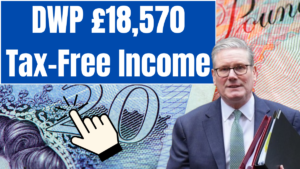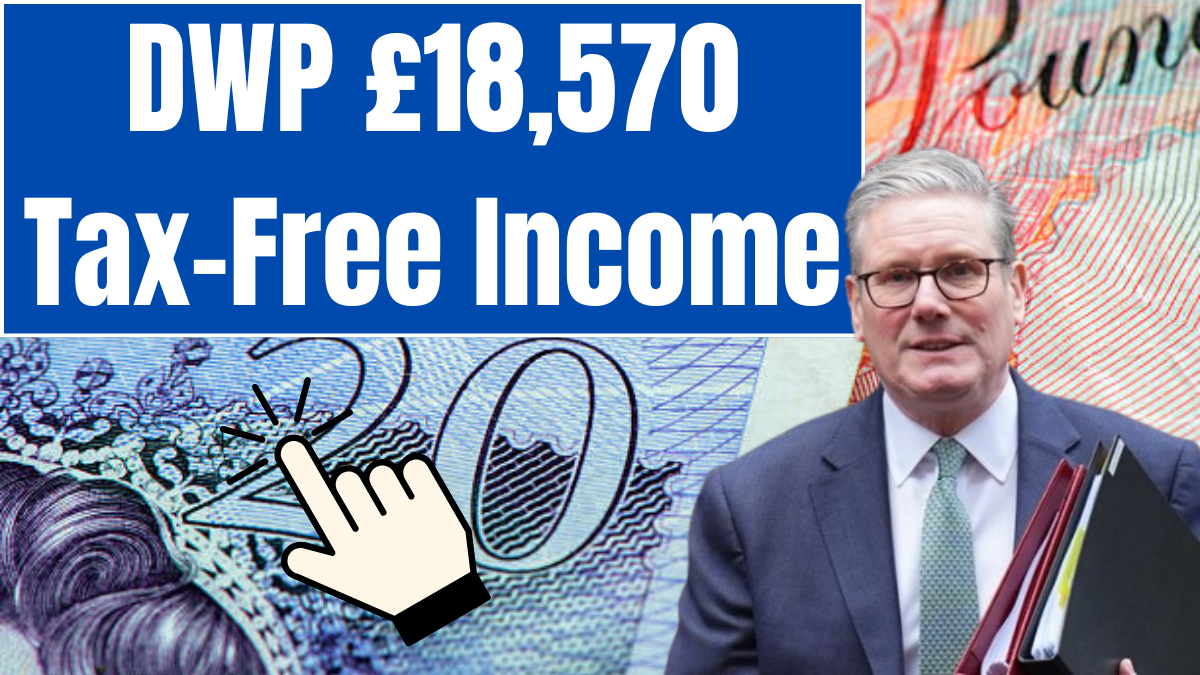As UK households continue to face financial strain, knowing how to retain more of your income tax-free is crucial. The DWP £18,570 Tax-Free Income 2025 isn’t a standalone benefit but a smart use of existing HMRC rules. By combining the Personal Allowance, the Starting Rate for Savings, and the Personal Savings Allowance, individuals can potentially earn up to £18,570 without paying any income tax.
This guide explains how these allowances work, who can benefit, and how to maximize their potential in the 2025/26 tax year.

What Is the DWP £18,570 Tax-Free Income 2025?
This figure is the result of combining three HMRC allowances legally available to UK residents:
-
Personal Allowance: £12,570
-
Starting Rate for Savings: Up to £5,000
-
Personal Savings Allowance: Up to £1,000
If structured wisely, these allowances let pensioners, part-time workers, and savers keep more of their income without being taxed.
Overview Table: Key Facts
| Aspect | Details |
|---|---|
| Total Tax-Free Income | £18,570 |
| Tax Year | 2025/26 |
| Allowances Combined | Personal Allowance, Starting Rate for Savings, Personal Savings Allowance |
| Managed By | HMRC |
| Best For | Low-income workers, pensioners, savers |
| Where to Apply | HMRC.gov.uk, GOV.UK |
Breakdown of the Three Tax-Free Allowances
1. Personal Allowance – £12,570
Everyone in the UK can earn this amount tax-free, whether it’s from wages, pension income, rental income, or taxable benefits. It’s the base threshold before any income tax is due.
2. Starting Rate for Savings – Up to £5,000
If your non-savings income is below £12,570, you can also earn up to £5,000 in interest on savings without paying tax. This gradually reduces as your earnings exceed the Personal Allowance threshold.
3. Personal Savings Allowance – Up to £1,000
This allows tax-free interest income based on your tax band:
-
Basic rate taxpayer: £1,000
-
Higher rate taxpayer: £500
-
Additional rate taxpayer: Not eligible
This is in addition to the above allowances and applies to interest earned on savings.
Who Can Benefit from the £18,570 Limit?
To benefit fully, you need to:
-
Be a UK resident
-
Have a non-savings income of £12,570 or less
-
Generate savings interest through bank or investment accounts
-
Be a basic rate or non-taxpayer
This structure benefits:
-
Retired individuals with modest pensions
-
Self-employed people with variable incomes
-
Part-time workers
-
Low-income households with savings
Smart Ways to Maximize Your Tax-Free Income
Separate and Track Income Sources
Keep savings and other income streams separate to clearly identify what falls under each allowance.
Use ISA Accounts
Interest from ISAs is always tax-free and doesn’t count towards the £18,570. Use these for added protection.
Plan with Your Partner
Spouses or civil partners can distribute savings and income to double the benefit—up to £37,140 tax-free combined.
Stagger Savings Interest
Consider timing interest earnings across two tax years to avoid breaching any one-year limits.
Use HMRC’s Online Tools
Use HMRC calculators to check your tax status, allowance usage, and how to optimize your finances.
Why This Matters in 2025
With rising living costs, maximizing non-taxable income is a practical way to ease pressure on household budgets. Unlike benefits, these allowances are not means-tested—they’re available to anyone who meets the income criteria.
Taking full advantage of them ensures more money stays in your pocket.
FAQs
Can I still benefit if I earn more than £18,570?
Yes. While you may not qualify for the full benefit, you can still use your Personal Savings Allowance based on your tax bracket.
Do these allowances apply to dividends or capital gains?
No. These are separate categories with their own allowances and tax rates.
Is ISA interest included in the £18,570?
No. ISA interest is entirely tax-free and doesn’t count towards the combined allowances.
What if I only have savings and no pension or salary?
If your total income from savings is within the combined limits, you could still enjoy tax-free status.
Do I need to apply for these allowances?
They’re usually applied automatically through your tax code, but always check your HMRC records or consult a financial advisor.
Conclusion
The DWP £18,570 Tax-Free Income 2025 is an underutilized advantage for many. It isn’t a benefit handed out but a strategic combination of allowances that can help retirees, part-time earners, and savers keep more of what they earn.
By planning smartly and knowing your entitlements, you can reduce or even eliminate your tax bill for the year.
Aanchal is a passionate writer with a keen interest in storytelling, content creation, and creative expression. She enjoys exploring diverse topics and crafting engaging narratives that captivate readers.

